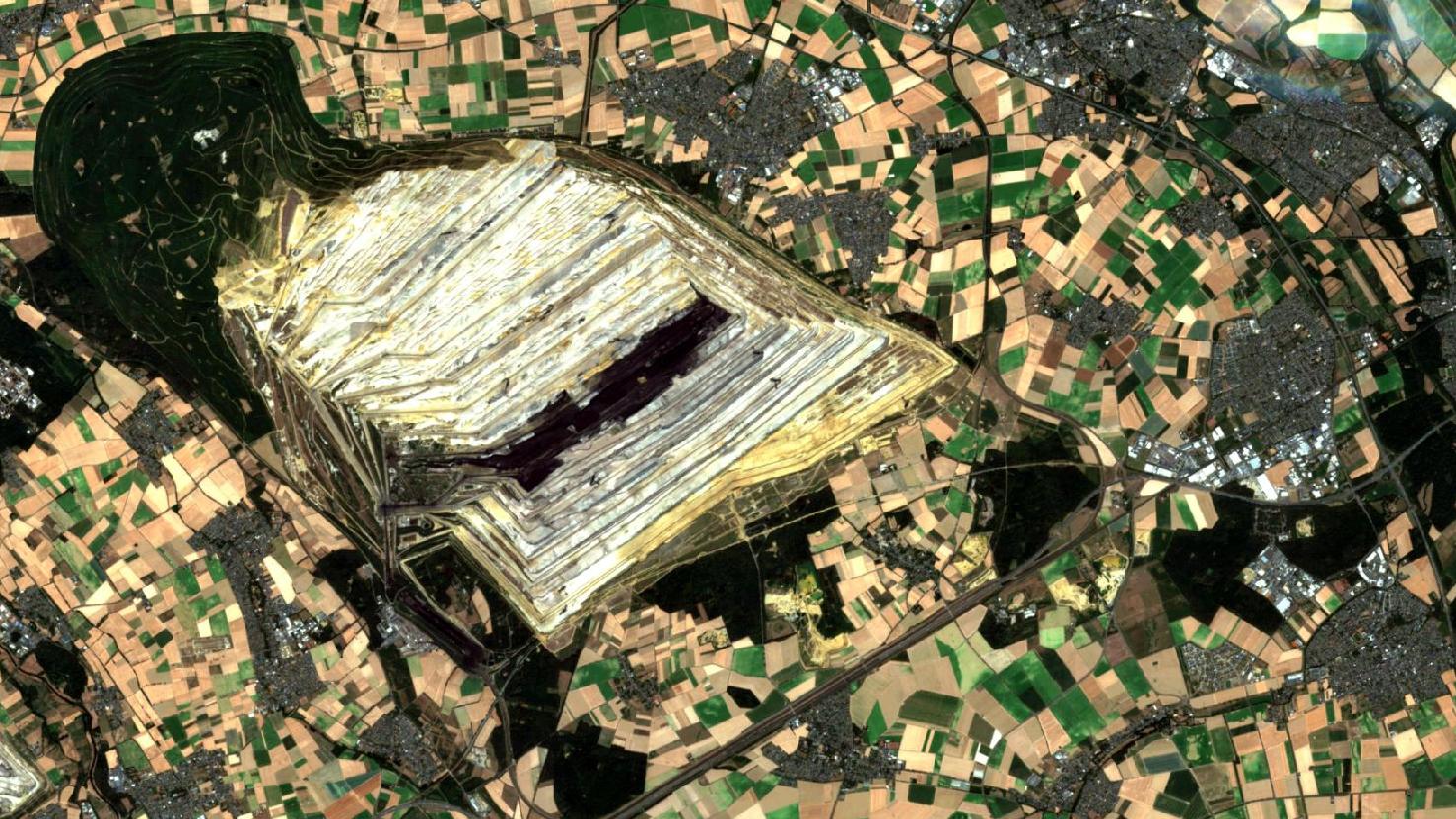Hambacher Forst
Das Satellitenbild des Monats Oktober zeigt in der Mitte den Tagebau Hambach sowie den im Süden angrenzenden Hambacher Forst und die im Osten gelegenen Dörfer Elsdorf und Sindorf. Die gesamte auf dem Bild gezeigte Region befindet sich im deutschen Bundesland Nordrhein-Westfalen. Die Aufnahme basiert auf Sentinel-2 Daten des Copernicus Programmes. Sentinel-2 Daten sind multispektrale Satellitenaufnahmen, die frei verfügbar sind. Nach dem Download wurde die Szene mit freier Software atmosphärenkorrigiert und mit drei verschiedenen Bändern eine Echtfarbenkomposition berechnet.
Mit besonders hellen Farbtönen sowie einem sehr dunklen bzw. schwarzen Streifen in der Mitte lässt sich die Grube des Tagebau Hambachs leicht in der Mitte des Bildes identifizieren. In dieser werden pro Jahr etwa 40 Millionen Tonnen Braunkohle gefördert, somit ist der Tagebau Hambach der größte von RWE betriebene Braunkohletagebau. Nur schwer sind die verschiedenen Erdschichten bzw. Stufen auszumachen die in der helleren sandfarbenen Erde um die Grube gegraben wurden um die Braunkohle zu fördern. Auf der nach Süden gelegenen Seite des Tagebaus befindet sich der letzte Teil des Hambacher Forsts, welcher nicht für die Grube das Tagebaus weichen musste. Die derzeitige Fläche des Hambacher Forsts beträgt 200 Hektar, während sie noch vor etwa 40 Jahren 4000 Hektar betrug.
Der Hambacher Forst gilt als Symbol des Widerstands der Anti-Kohlekraft-Bewegung gegen die Umweltzerstörung und Klimaschädigung durch die Kohlewirtschaft, sowie des bevorstehenden Kohleausstiegs als Teil der Energiewende. In den letzten Monaten und Jahren besetzten zahlreiche Aktivisten und Naturschützer mit Baumhäusern den Forst um eine geplante Rodung ab 14.10.2018 zu stoppen. Bis auf etwa 100ha Wald soll dieser dem Tagebau Hambach weichen um die für die Energieversorung des Landes benötigte Braunkohle weiterhin fördern zu können. Nachdem die geplante Rodung durch das Oberverwaltungsgericht Münster vorerst gestoppt wurde und eine Großdemonstration am Wald stattfand, stellte die Landesregierung die Räumung der Baumhäuser ein.
Das im Nordwesten des Bildes zu erkennende Waldstück wurde von RWE seit Beginn der Rodungen in diesem Gebiet aufgeforstet. Die sogenannte Sophienhöhe ist eine circa 1300 Hektar große rekultivierte Abraumhalde, ihr größter Teil liegt auf dem Gebiet des ursprünglichen Hambacher Forstes. Naturschützer und Waldpädagogen kritisieren jedoch, dass die aufgeforstete Fläche nicht gleichzusetzen ist mit dem Verlust des mehrere Jahrhunderte alten Hambacher Forsts. Der Hambacher Forst gilt als Wald mit hoher ökologischer Wertigkeit, die sich aus Relikten von wärmeliebenden Arten ergibt, die in den Altwäldern vorkommen.
Contains modified Copernicus Sentinel data (2017-2018)/ESA – created by mundialis
Weitere Satellitenbilder gibt es unter https://maps.mundialis.de
Die Erde als Kunstwerk: https://art.mundialis.de

